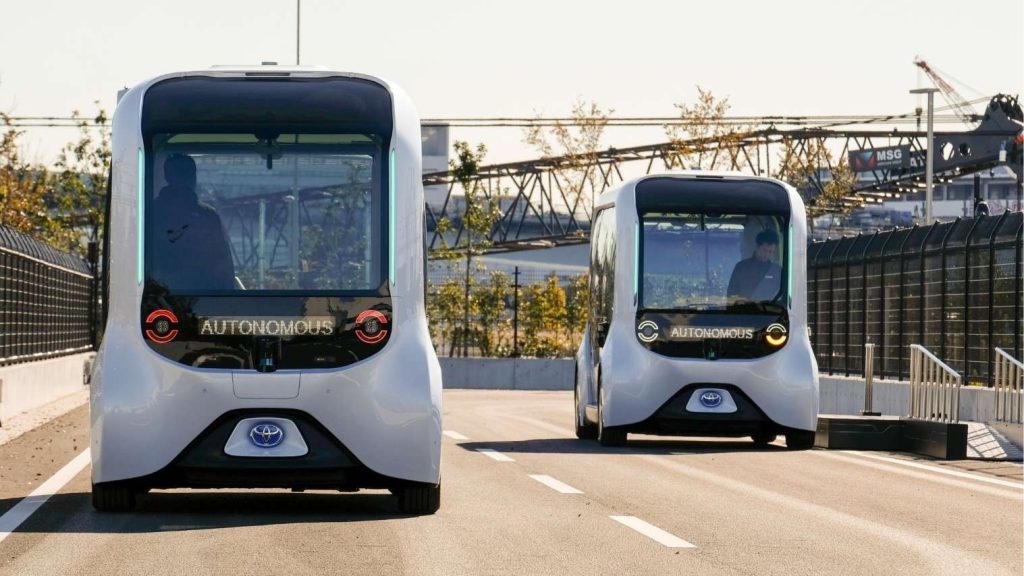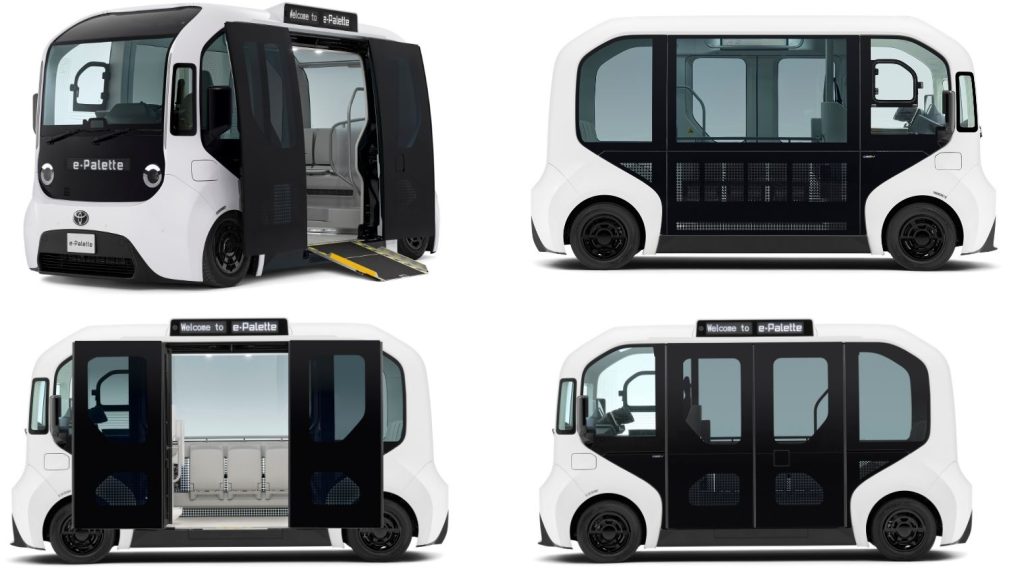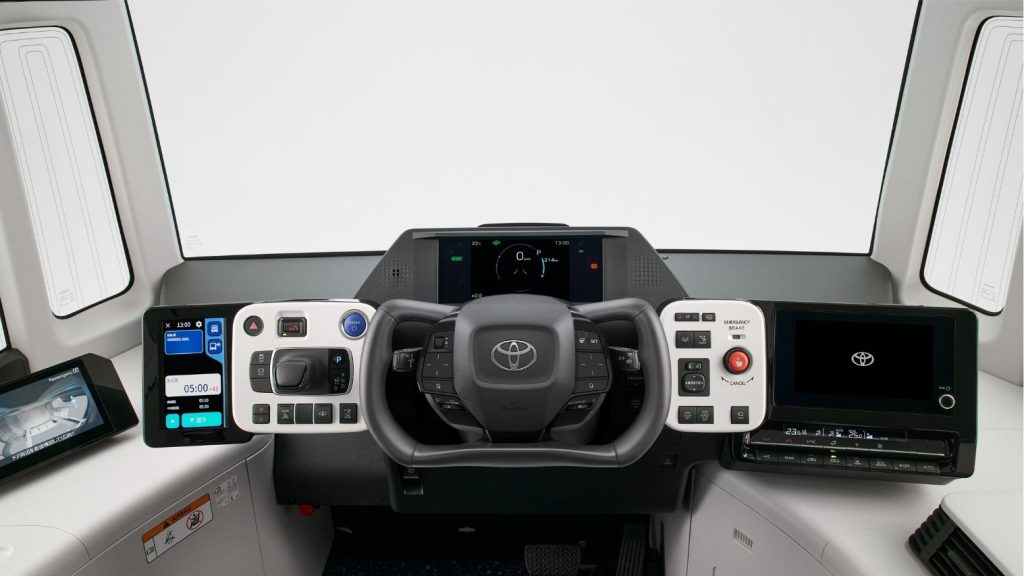Here is a detailed look at Toyota’s newly debuted autonomous electric vehicle, the e-Palette, with its 250 km range, its features, planned roll-out, and the implications.
What is the Toyota e-Palette?
The e-Palette is Toyota’s latest mobility vehicle, combining electric propulsion, modular interior use, and automated driving compatibility. It’s part of Toyota’s push to offer more than just cars—towards flexible mobility, shared usage, and autonomous services.
Key highlights:
- Fully electric with a lithium-ion battery pack of 72.82 kWh.
- Cruising range of approximately 250 km (about 155 miles), under WLTC mode (urban + suburban driving).
- Top speed is limited to 80 km/h.
- The vehicle supports rapid charging (DC 90 kW / 200 A) to 80% in ~40 minutes; standard AC charging (6 kW / 30 A) takes ~12 hours.
Design, Size, Capacity, & Versatility
Toyota designed the e-Palette as a large, boxy pod/shuttle with flexible interior usage. Some of its physical and usage attributes:
- Dimensions: about 4,950 mm long × 2,080 mm wide × 2,650 mm high.
- It can carry up to 17 people (driver + 4 seated + 12 standing).
- Low-floor design for easier entry; includes wide sliding doors; option of a height-adjustment and electric ramp — helpful for wheelchair access.
- Interior/customization: the cabin can be adapted depending on need—people mover, delivery, mobile shop, pop-up store, or even entertainment usages. Digital signage inside and out.
Autonomous Driving & Technology
While the e-Palette is being introduced in a mode that still requires driver presence/oversight, its architecture is designed with autonomous driving in mind:
- Currently fits Level-2 driver assistance systems (so partial autonomy: assisting driver, but driver must remain engaged).
- Toyota has an “Automated Driving Kit” (ADK) and a Vehicle Control Interface (VCI) that allow integration of hardware/software (sensors, cameras, LiDAR, etc.) from various providers, to support future autonomous driving.
- Toyota’s goal is to have vehicles capable of Level-4 autonomy (high automation; vehicle can perform all driving tasks under certain conditions without human input) by fiscal year 2027.
Practical Performance & Charging
- The 250 km range is based on WLTC (urban + suburban) usage; real-world range may vary depending on load, weather, and driving style.
- Rapid DC charging support allows ~80% full charge in about 40 minutes. AC slow charging (common in many places overnight) takes about 12 hours.
- The motor is an AC synchronous type, with a maximum output of 150 kW and torque of 266 N·m.
Cost, Market & Rollout
- In Japan, the starting price is ¥29,000,000 (including tax).
- It is eligible for government subsidies under Japan’s Commercial Vehicle Electrification Promotion Project: subsidy amount ~ ¥15,835,000.
- Sales are currently “built to order”, rather than mass production.
- Initial deployment / demonstrations planned in Japan: at Toyota Arena Tokyo, in Toyota Woven City, and surrounding areas.
Implications: What It Means for Mobility & EV/Autonomous Trends
- Flexible-use vehicles: The e-Palette represents a move toward vehicles that serve multiple functions — not just transporting people but also acting as mobile commerce, or providing community services, etc. This flexibility can help make EVs/autonomous vehicles more economically viable, especially in urban settings.
- Autonomy progression: By designing from the start to support higher levels of autonomy, Toyota is positioning itself to upgrade rather than redesign. The move to Level-4 in 2027 is ambitious but reflects confidence in software/sensor integration.
- Charging infrastructure & usage patterns: With moderate range and fast DC charging, the vehicle is suited to urban/suburban shuttle duties more than long highway trips. Charging infrastructure (especially rapid chargers) becomes more important.
- Cost vs subsidy: The high price tag means this vehicle is likely to be used by commercial operators, governments, or for projects (mobility services, public transport, etc.), particularly when subsidies bring the cost down.
- Regulation & safety: Autonomous systems bring in questions of regulation, liability, and safety, especially in mixed traffic. Toyota’s inclusion of safety systems (redundancy, robust sensors, cabin monitoring, etc.) is important, but deployment of higher autonomy will require regulatory approval.
- Urban design & sustainability: Such vehicles can reduce emissions, noise (EV benefits), traffic congestion (if used as shared shuttle services), and offer more flexible mobility—especially for those without cars or with limited mobility.
Limitations & Challenges
- Range limitation: 250 km is good for urban/suburban, but might not suffice for long intercity usage or in harsher climates (where battery performance drops).
- Max speed capped at 80 km/h limits use on highways or fast arterials.
- High upfront cost—even with subsidies, the cost may be prohibitive for smaller operators.
- Autonomy maturity: Level-4 is still some time away; local regulation, safety, and public acceptance will affect deployment and use.
- Charging infrastructure trust: To make full use, fast charging must be widely available; downtime for charging during frequent use could be operationally problematic.
Conclusion
Toyota’s e-Palette is a major step toward multi-purpose electric autonomous capable mobility. With a 72.82 kWh battery, a usable 250 km cruising range, rapid charging, and flexibility in interior usage, it embodies Toyota’s vision of “Beyond Zero” mobility: not just zero emissions, but adding value in transportation, services, and society.
It’s not perfect, especially for long-distance or high-speed scenarios, but as a city shuttle/people mover / mobile services platform, it has strong promise. Its success will depend on regulatory support, infrastructure, costs, and how well autonomous systems (and public trust) evolve over the next few years, especially toward that 2027 goal for Level-4 autonomy.



